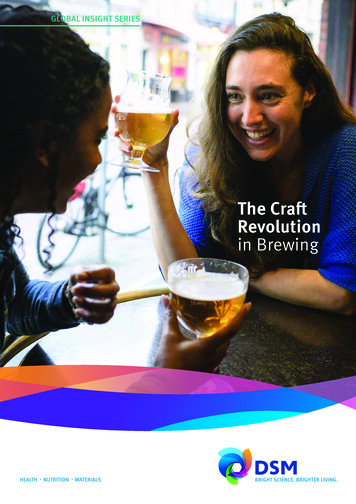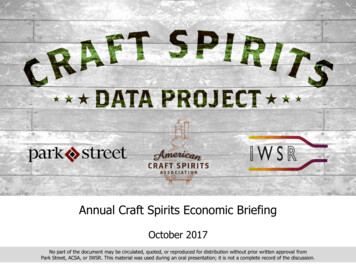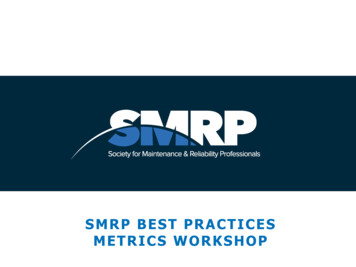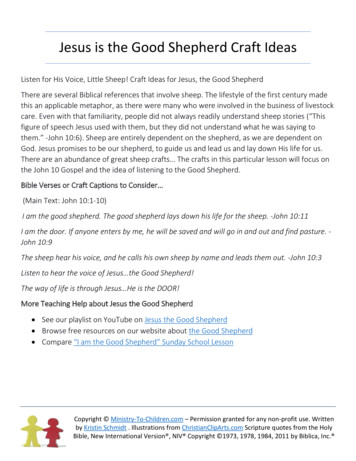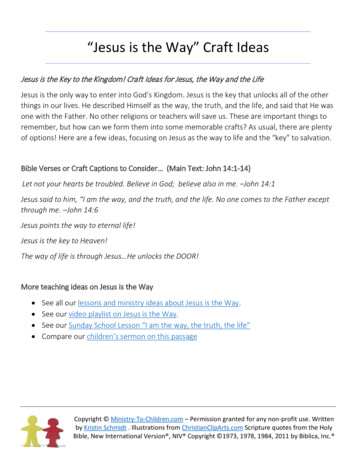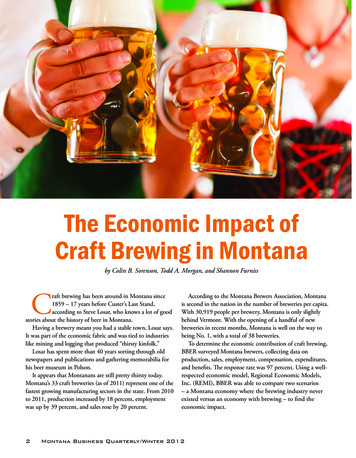
Transcription
The Economic Impact ofCraft Brewing in Montanaby Colin B. Sorenson, Todd A. Morgan, and Shannon FurnissCraft brewing has been around in Montana since1859 – 17 years before Custer’s Last Stand,according to Steve Losar, who knows a lot of goodstories about the history of beer in Montana.Having a brewery meant you had a stable town, Losar says.It was part of the economic fabric and was tied to industrieslike mining and logging that produced “thirsty kinfolk.”Losar has spent more than 40 years sorting through oldnewspapers and publications and gathering memorabilia forhis beer museum in Polson.It appears that Montanans are still pretty thirsty today.Montana’s 33 craft breweries (as of 2011) represent one of thefastest growing manufacturing sectors in the state. From 2010to 2011, production increased by 18 percent, employmentwas up by 39 percent, and sales rose by 20 percent.2According to the Montana Brewers Association, Montanais second in the nation in the number of breweries per capita.With 30,919 people per brewery, Montana is only slightlybehind Vermont. With the opening of a handful of newbreweries in recent months, Montana is well on the way tobeing No. 1, with a total of 38 breweries.To determine the economic contribution of craft brewing,BBER surveyed Montana brewers, collecting data onproduction, sales, employment, compensation, expenditures,and benefits. The response rate was 97 percent. Using a wellrespected economic model, Regional Economic Models,Inc. (REMI), BBER was able to compare two scenarios– a Montana economy where the brewing industry neverexisted versus an economy with brewing – to find theeconomic impact.Montana Business Quarterly/Winter 2012
Table 1Montana Brewery Survey Data SummaryHaving a brewerymeant you had astable town, Losarsays. It was part of theeconomic fabric andwas tied to industrieslike mining andlogging that produced“thirsty 87,442 Barrels102,925 Barrels18%Beer sales 21.8 Million 26.1 Million20%Employment231 Jobs320 Jobs39%Compensation 5.2 Million 6.4 Million23%Expenditures* 15.6 Million 18.8 Million21%* Excluding employee compensation.Source: Bureau of Business and Economic Research, The University of Montana.Figure 1Montana Brewery ExpendituresSurvey FindingsFrom 2010 to 2011, production at Montana breweriesincreased from just over 87,000 barrels to nearly 103,000barrels. Beer sales increased from just under 22 million tomore than 26 million. Employment, including both fulland part-time jobs, increased from 231 to 320 from 2010to 2011 – a 39 percent increase. Compensation (wages andsalaries plus the value of benefits packages) increased from 5.2 million to 6.4 million from 2010 to 2011 – a 23percent increase. Expenditures (excluding labor) increasedfrom 15.6 million to 18.8 million from 2010 to 2011 – a21 percent overall increase (Table 1).As shown in Figure 1, brewers were asked what portionof their expenditures, other than employee compensation,occurred in Montana. Overall, expenditures rose by 21percent, from 15.6 million to 18.8 million. The Montanaportion of expenditures rose from 6 million (38 percent oftotal expenditures) in 2010 to 7.5 million (40 percent oftotal expenditures) in 2011. The percentage of expendituresmade within the state varied widely among brewers, andbrewers reported that anywhere from 2 percent to 90 percentof their expenditures were in Montana. Some brewers notedthat they would prefer to buy more supplies from withinMontana, but they were unable to obtain some of theirproducts locally.Providing health insurance and other benefits is clearly ahigh priority for many breweries in the state. Figure 2 showsthe number of breweries that offer various benefits to theiremployees including health insurance, dental insurance, lifeinsurance, retirement and disability, and paid vacation.Source: Bureau of Business and Economic Research, The University of Montana.Figure 2Montana Brewery Employee BenefitsSource: Bureau of Business and Economic Research, The University of Montana.Montana Business Quarterly/Winter 20123
Draught Works, Missoula, MTDraught Works, MissoulaWant to buy your friend a beer? Pull out yourwallet – or your iPhone. Through a newmobile app, beerfarmer.com, you can buy a pint ofScepter Head IPA or Quill Pig (classic style Pilsner) orwhatever Draught Works is brewing up and send it toyour friend via text message. Your friend can then claimand redeem his beer.Connecting with customers is importantto the management at Draught Works,and they’ve learned that their customersrespond well to technology and socialmedia. The brewery keeps theircustomers informed of new brews,live music, and other events viaFacebook and Twitter. Reminders of“Growler Monday” where customersget a free pint for filling up theirgrowler or “Chug for Charity,” where 50cents of each beer goes to a local nonprofitcome in a steady stream through postings andtweets. Special promotions posted regularly – like ski toDraught Works (or show your skis/gear) and get a freepint – cater to Missoula’s recreationally minded beerdrinkers, keeping them tuned in and engaged.Paul Marshall and Jeff Grant opened the breweryon Toole Avenue a little over a year ago. Located inMissoula’s Westside neighborhood, the brewery is a4remodeled 5,000-square-foot warehouse that dates backto the 1930s. Red brick walls and a wooden bar madefrom a salvaged “boom” log from the bottom of FlatheadLake give the brewery a neighborhood kind of feel. Andmany of the customers who stop by for a brew live in theneighborhood.Last year, Draught Works – Missoula’s newestbrewery – produced 700 barrels, but theyexpect that number to increase as thebusiness continues to grow. The brewerykeeps five beers on tap at all times,though they have 15 to 20 differentrecipes that they create for specialoccasions – like the Last RitesMexican Chocolate Porter theybrewed for Missoula’s Festival of theDead parade in the fall. Draught Workshas 10 part-time employees who keepbusy milling, mashing, lautering, brewing,whirlpooling, cooling, fermenting, and serving uptheir specialties in the taproom.The business model of tasting and selling beer in thetaproom works for now, Marshall says, but they mayeventually get into distribution. It seems Missoulians arequite fond of Draught Works’ product.“I’d put Missoula up against any town in the nationfor savvy and culture and palette,” Marshall says.Montana Business Quarterly/Winter 2012
Economic Impact ResultsTable 2Results from the REMI economic impact simulation aresummarized in Table 2. This study finds that because thecraft brewing industry exists in Montana, the state economyis larger and more prosperous. Government revenues are alsohigher as a result of the industry. Because of the operations ofthe craft brewing industry: There is an employment impact of 434 jobs acrossvarious sectors of the state economy; In addition to the jobs in the manufacturing sector,there are significant impacts in the construction, healthcare, and retail trade sectors; There are employment and output (private sectorsales) impacts throughout the five regions of the state,though they are concentrated in the northwest region; Because of the brewing industry, output (private sectorsales) is 48.4 million higher than would otherwise bethe case; Private nonfarm compensation and governmentcompensation are 9.8 million and 1.8 millionEconomic Impacts ofBeer Brewing in MontanaCategoryTotal EmploymentOutput (Private Sector Sales)Impact434 Jobs 48.4 MillionCompensation (Private Nonfarm) 9.8 MillionCompensation (Government) 1.8 MillionState Government Revenues 1.5 MillionSource: Bureau of Business and Economic Research,The University of Montana. higher, respectively, than they would be without theexistence of craft brewing in Montana;State government revenues are 1.5 million higherthan they would be without the Montana craftbrewing industry.Beaver Creek Brewery, WibauxOut in far eastern Montana – on I-94 not too farfrom the North Dakota border – is Wibaux,population about 400. With not too much aroundbut vast plains and open road, two billboard signs pullpeople into what has become known as a microbrewoasis, Beaver Creek Brewery.Named after a creek that runsthrough Wibaux, Beaver CreekBrewery opened in the summer of2008 with six beers on tap, plus rootbeer. The Paddlefish Stout won a“people’s award,” but beer connoisseursalso are fond of the Redheaded IPA andRusty Beaver Wheat.Why open a brewery in Wibaux?“We had too many pints and decided itwas a good idea,” says Jim Devine, one ofthe partners at Beaver Creek Brewery. He andhis partners, Sandy Stinnett and Russell Houk, took 18months to remodel a historic downtown building thathas been many things in its lifetime – a grocery store,a shoe store, a butcher shop. In 2008, the partnersbrewed about 68 barrels of beer. As the brewery grew inpopularity, so did its production. Last year, productionwas about 650 barrels.A country western musician who spent 12 yearsrecording in Nashville, Devine still has connections andbrings in live music for his customers. Blind Pilot, anindie folk band from Portland, was oneof the groups. Playing at the brewery,which holds only 100 people, is a uniqueexperience for some of the bigger groups.Devine is not adverse to picking up hisguitar and holding Sunday afternoonjam sessions.One of the frustrations Devineshares with fellow microbrewers is thefact that taproom laws are restrictive,with limited hours, only a certain numberof pints allowed, and other productionlimits. He recently opened a restaurantnext door, the Gem, that will serve Beaver Creek’sbeer through a beer and wine license held by a familymember. Several other Montana brewers are looking intoimplementing this type of business model.Montana Business Quarterly/Winter 20125
Big Sky Brewing, MissoulaWho could resist trying a beer called MooseDrool? Or Scapegoat, or Powder Hound,or Trout Slayer? With catchy names and tasty beers,Big Sky Brewing is the biggest brewery in the statewith production of about 46,000 barrels of beer inthe past year. That works out to around 630,000 casesor nearly 2.5 million six packs of beer that thebrewery sold throughout Montana and in 24states west of the Mississippi (except Arkansasand Louisiana) plus Wisconsin, Illinois, andMichigan.Owners Neal Leathers, Bjorn Nabozney,and Brad Robinson brewed their first batch ofbeer, Whistle Pig Red Ale, in the summer of1995, and it hit the market in time for the4th of July weekend. When they first startedthinking about names of beers, they decidedthey wanted to use big Montana animalsas their theme. The most famous of thecompany’s brands, Moose Drool, has a labelwith a moose lifting his head from a pondwith water streaming off his muzzle.Big Sky Brewing was a draft-only breweryfor the first few years. They soon realizedthat they were growing rapidly and becoming a6regional player. The owners decided to start bottlingand distributing their beer. In 2002, they moved intoa larger site (24,000-square-feet) near the Missoulaairport to accommodate their growing operation.The brewery has a gift shop and hosts concerts at itsoutdoor venue. Some of the concerts have includedBob Dylan, Brandi Carlile, the Decemberists, andModest Mouse, with the proceeds of beer sales goingto local area nonprofits. Missoula’s Glacier Ice Rinkwas one of the beneficiaries, receiving more than 30,000 to construct new locker rooms.The brewery started out as a four-personoperation. Now it has 45 employees with a payrollof about 2.35 million. Big Sky Brewing offersemployees health insurance, 401K plans, and paidvacation.According to Big Sky Brewing PresidentNeal Leathers, the owners’ future plans includecontinuing to expand their territory and gettingtheir beers into more stores, restaurants, andtaverns.Montana Business Quarterly/Winter 2012Big Sky Brewing is the biggestbrewery in the state withproduction of about 46,000barrels of beer in the past year.
Figure 3Figure 4Employment Impacts by Industry(Number of Workers)Output (Gross Sales) Impacts by Industry(Private Sector, Millions of Dollars)Source: Bureau of Business and Economic Research, The University of Montana.Source: Bureau of Business and Economic Research, The University of Montana.Impacts by Industry Sectorand Montana RegionEconomic impacts of the brewing industry are spreadacross several industry sectors and also dispersed across thestate. Clearly, the manufacturing sector, which includes thebrewing industry, holds the largest share of the employmentimpacts, as shown in Figure 3.However, the employment impacts of the brewing industryare revealed in several other sectors as well. This includes 29jobs in state and local government, 24 jobs in construction,14 jobs in retail trade, 10 jobs in health care, and 38additional jobs in other sectors. Output impacts (Figure 4),measured by private sector gross sales total, are 48.4 million, 39.5 million of which can be attributed to manufacturing.While concentrated in the more populous regions of thestate, economic impacts due to craft brewing extend into eachregion of the state. For the purpose of the analysis, impactswere split into five Montana regions (Figure 5). At of theend of 2011, there were 12 breweries in northwest Montana,seven in southwest Montana, four in north central Montana,eight in south central Montana, and two in eastern Montana.Figure 5Economic Regions and Number of Active Breweries, 2011Source: Bureau of Business and Economic Research, The University of Montana.Montana Business Quarterly/Winter 20127
8Montana Business Quarterly/Winter 2012
MBozeman Brewing Company, Bozemanontana breweries should work together to promotequality local hand-crafted beer that is brewed inthe state, according to Todd Scott, president of BozemanBrewing Company and board member of theMontana Brewers Association.“It’s likely we’re working toward thesame goals, and there is strength innumbers,” Scott says. “We are one voiceduring the legislative session.”From the time of Prohibitionwhen alcohol was banned, the craftbrewing industry has faced challenges.Whether it’s fighting increasing taxes orcompetition from international corporationsthat dominate markets, brewers should shareinformation with each other, he says.Scott, who calls himself and his wife, Lisa, check signers/chief keg and bottle washers/maintenance specialists akaowners, opened the brewery in 2001 after having workedas head brewer for 10 years at Spanish Peaks, a trendyBozeman brewery that moved production to California. Toget their start, they bought the brewing equipment fromSpanish Peaks. It wasn’t long before they developed BozemanBrewing’s flagship beer, Bozone Select Amber Ale.A whimsical name for the Bozeman area, Bozoneseems to be well-liked by most customers inthe tasting room, who range from cowboysto patchouli-wearing hippies to universityprofessors, Scott says. Last year, the brewery,with a handful of employees (waterenhancement specialist aka head brewer,sellerman aka manager, lab rat aka brewer, toname a few), produced 3,400 barrels. Theyalso started to can Bozone beer and sell it ina few markets outside of Bozeman. The canswere designed for Bozeman’s recreationally orientedcommunity – bikers, hikers, and skiers – who could carrythem easily in backpacks.Future plans include continuing to expand and offeringIPA, Porter, and Hefeweizen in cans. “We may not ever be thebiggest, but we’ll have smart, controlled growth and try to filleveryone’s need for beer.”Figures 6 and 7 show output and the employment impacts by be conducted to monitor changes in the economic impact ofthe industry over time. Furthermore, the effects of legislativeregion, respectively.changes could be modeled to inform policymakers on theConclusionimpact of changing legislation on the Montana economy.qBased on the data collected from Montana breweries, theindustry grew rapidly from 2010 to 2011. This analysis hasColin B. Sorenson is a research economist at the Bureau ofdeveloped a baseline economic impact of the brewing industry Business and Economic Research, Todd A. Morgan is the directoron Montana’s economy and established that it is a healthyof forest industry and manufacturing research. Shannon Furnissand growing sector. In the future, additional research couldis BBER’s communications director.Figure 7Figure 6Employment Impacts ofMontana Brewing by RegionOutput (Gross Sales) Impacts ofMontana Brewing by RegionSource: Bureau of Business and Economic Research, The University of Montana.Source: Bureau of Business and Economic Research, The University of Montana.Montana Business Quarterly/Winter 20129
recipes that they create for special occasions - like the Last Rites Mexican Chocolate Porter they brewed for Missoula's Festival of the Dead parade in the fall. Draught Works has 10 part-time employees who keep busy milling, mashing, lautering, brewing, whirlpooling, cooling, fermenting, and serving up their specialties in the taproom.



